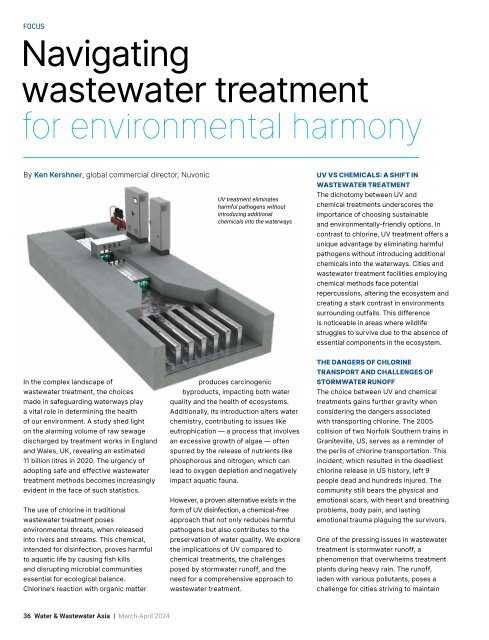Water & Wastewater Asia March/April 2024
Water & Wastewater Asia is an expert source of industry information, cementing its position as an indispensable tool for trade professionals in the water and wastewater industry. As the most reliable publication in the region, industry experts turn this premium journal for credible journalism and exclusive insight provided by fellow industry professionals. Water & Wastewater Asia incorporates the official newsletter of the Singapore Water Association (SWA).
Water & Wastewater Asia is an expert source of industry information, cementing its position as an indispensable tool for trade professionals in the water and wastewater industry. As the most reliable publication in the region, industry experts turn this premium journal for credible journalism and exclusive insight provided by fellow industry professionals. Water & Wastewater Asia incorporates the official newsletter of the Singapore Water Association (SWA).
You also want an ePaper? Increase the reach of your titles
YUMPU automatically turns print PDFs into web optimized ePapers that Google loves.
FOCUS<br />
Navigating<br />
wastewater treatment<br />
for environmental harmony<br />
By Ken Kershner, global commercial director, Nuvonic<br />
UV treatment eliminates<br />
harmful pathogens without<br />
introducing additional<br />
chemicals into the waterways<br />
UV VS CHEMICALS: A SHIFT IN<br />
WASTEWATER TREATMENT<br />
The dichotomy between UV and<br />
chemical treatments underscores the<br />
importance of choosing sustainable<br />
and environmentally-friendly options. In<br />
contrast to chlorine, UV treatment offers a<br />
unique advantage by eliminating harmful<br />
pathogens without introducing additional<br />
chemicals into the waterways. Cities and<br />
wastewater treatment facilities employing<br />
chemical methods face potential<br />
repercussions, altering the ecosystem and<br />
creating a stark contrast in environments<br />
surrounding outfalls. This difference<br />
is noticeable in areas where wildlife<br />
struggles to survive due to the absence of<br />
essential components in the ecosystem.<br />
In the complex landscape of<br />
wastewater treatment, the choices<br />
made in safeguarding waterways play<br />
a vital role in determining the health<br />
of our environment. A study shed light<br />
on the alarming volume of raw sewage<br />
discharged by treatment works in England<br />
and Wales, UK, revealing an estimated<br />
11 billion litres in 2020. The urgency of<br />
adopting safe and effective wastewater<br />
treatment methods becomes increasingly<br />
evident in the face of such statistics.<br />
The use of chlorine in traditional<br />
wastewater treatment poses<br />
environmental threats, when released<br />
into rivers and streams. This chemical,<br />
intended for disinfection, proves harmful<br />
to aquatic life by causing fish kills<br />
and disrupting microbial communities<br />
essential for ecological balance.<br />
Chlorine’s reaction with organic matter<br />
produces carcinogenic<br />
byproducts, impacting both water<br />
quality and the health of ecosystems.<br />
Additionally, its introduction alters water<br />
chemistry, contributing to issues like<br />
eutrophication — a process that involves<br />
an excessive growth of algae — often<br />
spurred by the release of nutrients like<br />
phosphorous and nitrogen, which can<br />
lead to oxygen depletion and negatively<br />
impact aquatic fauna.<br />
However, a proven alternative exists in the<br />
form of UV disinfection, a chemical-free<br />
approach that not only reduces harmful<br />
pathogens but also contributes to the<br />
preservation of water quality. We explore<br />
the implications of UV compared to<br />
chemical treatments, the challenges<br />
posed by stormwater runoff, and the<br />
need for a comprehensive approach to<br />
wastewater treatment.<br />
THE DANGERS OF CHLORINE<br />
TRANSPORT AND CHALLENGES OF<br />
STORMWATER RUNOFF<br />
The choice between UV and chemical<br />
treatments gains further gravity when<br />
considering the dangers associated<br />
with transporting chlorine. The 2005<br />
collision of two Norfolk Southern trains in<br />
Graniteville, US, serves as a reminder of<br />
the perils of chlorine transportation. This<br />
incident, which resulted in the deadliest<br />
chlorine release in US history, left 9<br />
people dead and hundreds injured. The<br />
community still bears the physical and<br />
emotional scars, with heart and breathing<br />
problems, body pain, and lasting<br />
emotional trauma plaguing the survivors.<br />
One of the pressing issues in wastewater<br />
treatment is stormwater runoff, a<br />
phenomenon that overwhelms treatment<br />
plants during heavy rain. The runoff,<br />
laden with various pollutants, poses a<br />
challenge for cities striving to maintain<br />
36 <strong>Water</strong> & <strong>Wastewater</strong> <strong>Asia</strong> | <strong>March</strong>-<strong>April</strong> <strong>2024</strong>

















